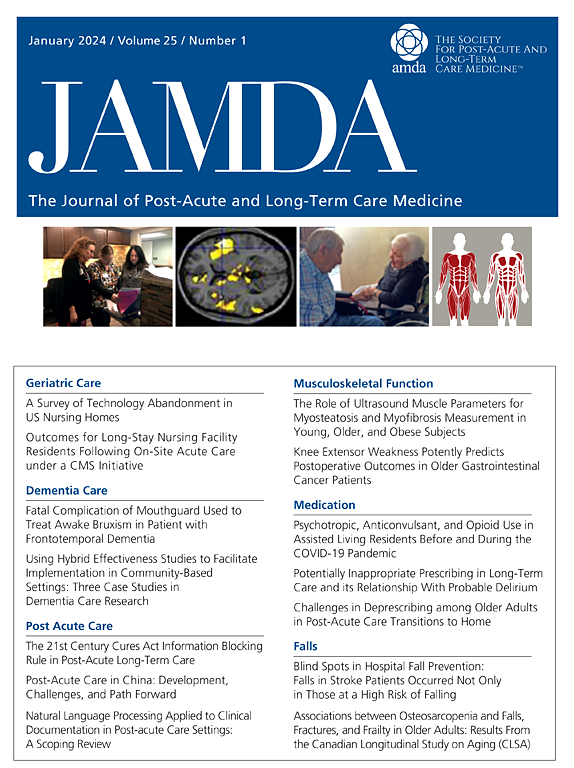澳大利亚长期护理机构的星级评定:与高评级相关的机构特征以及评级随时间的变化。
IF 3.8
2区 医学
Q2 GERIATRICS & GERONTOLOGY
Journal of the American Medical Directors Association
Pub Date : 2024-09-19
DOI:10.1016/j.jamda.2024.105272
引用次数: 0
摘要
目标:澳大利亚的长期护理机构星级评定系统(1 星至 5 星)基于 4 个子类别:合规性、质量措施、居民体验和人员配置。目标:研究机构特征与获得 4 星或 5 星评级几率之间的关系,以及最早报告期(2022 年 10 月至 12 月)至最近报告期(2023 年 4 月至 6 月)之间评级的变化:设计:横断面生态研究,附加纵向研究:环境:澳大利亚的长期护理机构:方法:采用多元逻辑回归模型研究机构特征与获得 4 星或 5 星评级几率之间的关系。结果:在 2476 家机构中,53.7% 的机构获得了 4 星或 5 星评级:在 2023 年 4 月至 6 月的报告期内,2476 家医疗机构中有 53.7% 获得了 4 星或 5 星评级,44.1% 获得了 3 星评级,2.1% 获得了 1 星或 2 星评级。与获得 4 星或 5 星评级几率较高相关的机构特征包括小型机构(≤60 名居民)和中型机构(61-100 名居民)(几率比分别为 3.16;95% CI,2.51-3.98 和 1.72;05% CI,1.38-2.13),以及昆士兰与新南威尔士相比的地理位置(2.42;95% CI,1.87-3.14)。与政府运营的医疗机构相比,社会经济条件较差地区的医疗机构(0.45;95% CI,0.33-0.62)、营利性医疗机构(0.12;95% CI,0.07-0.22)或非营利性医疗机构(0.16;95% CI,0.09-0.29)获得 4 星或 5 星评级的几率较低。在两个报告期之间,25.1% 的机构的星级评分有所上升,10.2% 的机构评分有所下降(平均变化为 0.156)。居民体验、合规性和人员配备这三个子类别的加权平均评级变化最大(分别为 0.051、0.042 和 0.042):结论:规模较小、由政府所有以及位于社会经济条件较好地区的长期护理机构获得 4 星或 5 星评级的几率较高。随着时间的推移,平均星级评分有所提高,但总体评分和子类评分有升有降。本文章由计算机程序翻译,如有差异,请以英文原文为准。
Star Ratings in Long-Term Care Facilities in Australia: Facility Characteristics Associated with High Ratings and Changes in Ratings Over Time
Objectives
A Star Rating system (1 to 5 stars) of long-term care facilities in Australia is based on 4 sub-categories: compliance, quality measures, residents’ experience, and staffing. The objectives were to examine associations between facility characteristics and the odds of receiving a 4- or 5-star rating, and changes in ratings between the earliest reporting period (October–December 2022) to the most recent (April–June 2023).
Design
Cross-sectional, ecological study, with an additional longitudinal component.
Setting
Long-term care facilities in Australia.
Methods
Associations between facility characteristics and the odds of receiving a 4- or 5-star rating were examined using a multiple logistic regression model. Average changes in overall star rating and each sub-category weighted by fractional contribution to overall star rating were estimated.
Results
Of 2476 facilities, 53.7% received a 4- or 5-star rating, 44.1% a 3-star rating, and 2.1% a 1- or 2-star rating in the April–June 2023 reporting period. Facility characteristics associated with higher odds of 4- or 5-star ratings included small (≤60 residents) and medium-size (61–100 residents) (odds ratios, 3.16; 95% CI, 2.51–3.98 and 1.72; 95% CI, 1.38–2.13, respectively), and Queensland location compared with New South Wales (2.42; 95% CI, 1.87–3.14). Facilities in socioeconomically disadvantaged areas (0.45; 95% CI, 0.33–0.62) and for-profit (0.12; 95% CI, 0.07–0.22) or not-for-profit facilities (0.16; 95% CI, 0.09–0.29) compared with government-operated were associated with lower odds of 4- or 5-star ratings. Between the 2 reporting periods, 25.1% of facilities' star ratings increased and 10.2% decreased (average change 0.156). Residents’ experience, compliance, and staffing had the largest weighted average sub-category rating changes (0.051, 0.042, and 0.042, respectively).
Conclusions
Smaller size, government ownership, and location in socioeconomically advantaged areas were associated with higher odds of 4- or 5-star ratings in long-term care facilities. Average star ratings increased over time but increases and decreases in overall and sub-category ratings were observed.
求助全文
通过发布文献求助,成功后即可免费获取论文全文。
去求助
来源期刊
CiteScore
11.10
自引率
6.60%
发文量
472
审稿时长
44 days
期刊介绍:
JAMDA, the official journal of AMDA - The Society for Post-Acute and Long-Term Care Medicine, is a leading peer-reviewed publication that offers practical information and research geared towards healthcare professionals in the post-acute and long-term care fields. It is also a valuable resource for policy-makers, organizational leaders, educators, and advocates.
The journal provides essential information for various healthcare professionals such as medical directors, attending physicians, nurses, consultant pharmacists, geriatric psychiatrists, nurse practitioners, physician assistants, physical and occupational therapists, social workers, and others involved in providing, overseeing, and promoting quality

 求助内容:
求助内容: 应助结果提醒方式:
应助结果提醒方式:


